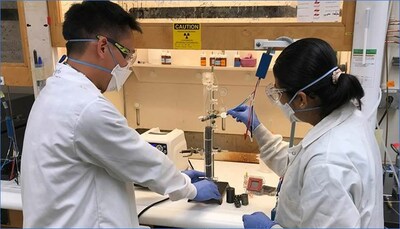SoCalGas Joins Lawrence Livermore National Laboratory and Electrochaea to Help Advance Gas Infrastructure Decarbonization
This innovative technology could help revolutionize biomethane production and help decarbonize gas infrastructure by displacing traditional natural gas with carbon-neutral synthetic biomethane.
"This technology is not just an innovative approach to energy generation; it has the potential to be a versatile solution that aligns with California's vision for carbon neutrality by 2045," said Jawaad Malik, Chief Strategy and Sustainability Officer at SoCalGas. "This project demonstrates our aspirations for a sustainable energy future and highlights how strategic collaborations can yield solutions designed to benefit the environment, the economy and our communities."
If developed at scale, this technology could increase the yield of RNG produced from carbon dioxide sources like anaerobic digesters, landfills, dairies, fermentation facilities or industrial processes. The hybrid bioreactor and electrolyzer system harnesses the power of Electrochaea's proprietary microbial biocatalyst, which consumes hydrogen and carbon dioxide, transforming these inputs into RNG.
"We believe this technology will help enable decarbonization of the natural gas grid infrastructure by providing a renewable source of natural gas," said Simon Pang, a materials scientist in LLNL's Materials Science Division who heads the project. "This renewable natural gas can be moved and used in existing infrastructure, allowing the technology to be deployed soon to meet green energy demand. Moreover, by producing pipeline-quality renewable natural gas from biogas, we can increase the value of biogas and reduce the likelihood that it will be vented to the atmosphere, reducing greenhouse gas emissions and improving local air quality."
The two-year project aims to efficiently combine the processes of electrolysis and methanation in one streamlined unit. A single unit would simplify how the system works, bring efficiency, lower costs, and have a potential to adjust to changing energy demand and renewable electricity sources.
"Electrochaea's team is highly committed to contributing to a safe, affordable, and environmentally friendly energy supply now and in the future. The new highly efficient single-stage bioreactor is an essential asset in this endeavor," said Dr. Doris Hafenbradl, Electrochaea's Chief Technology Officer and Managing Director. "We are excited to collaborate with SoCalGas and Lawrence Livermore National Laboratory who are undisputed leaders in their respective fields. The enthusiasm to continue and expand this collaborative effort is a testament to the shared commitment to making a meaningful impact on the energy landscape."
Cleaner energy innovations designed to help decarbonize hard-to-electrify sectors will be a key component of California's efforts to achieve carbon neutrality by 2045. To that end, SoCalGas continues to develop Angeles Link, a proposed clean renewable hydrogen pipeline system to serve Southern and
Learn more about how SoCalGas is working to help achieve a future through innovation, collaboration and decarbonization at https://www.socalgas.com/sustainability
About SoCalGas
Headquartered in
SoCalGas' mission is to build the cleanest, safest and most innovative energy infrastructure company in America. In support of that mission, SoCalGas aspires to achieve net-zero greenhouse gas emissions in its operations and delivery of energy by 2045 and to replace 20 percent of its traditional natural gas supply to core customers with renewable natural gas (RNG) by 2030. RNG can be made from waste created by landfills and wastewater treatment plants. SoCalGas is also investing in its gas delivery infrastructure while working to keep bills affordable for customers. SoCalGas is a subsidiary of Sempra (NYSE: SRE), an energy infrastructure company based in San Diego.
For more information visit socalgas.com/newsroom or connect with SoCalGas on X (formerly Twitter) (@SoCalGas), Instagram (@SoCalGas) and Facebook.
This press release contains forward-looking statements within the meaning of the Private Securities Litigation Reform Act of 1995. Forward-looking statements are based on assumptions about the future, involve risks and uncertainties, and are not guarantees. Future results may differ materially from those expressed or implied in any forward-looking statement. These forward-looking statements represent our estimates and assumptions only as of the date of this press release. We assume no obligation to update or revise any forward-looking statement as a result of new information, future events or otherwise.
In this press release, forward-looking statements can be identified by words such as "believe," "expect," "intend," "anticipate," "contemplate," "plan," "estimate," "project," "forecast," "envision," "should," "could," "would," "will," "confident," "may," "can," "potential," "possible," "proposed," "in process," "construct," "develop," "opportunity," "preliminary," "initiative," "target," "outlook," "optimistic," "poised," "maintain," "continue," "progress," "advance," "goal," "aim," "commit," or similar expressions, or when we discuss our guidance, priorities, strategy, goals, vision, mission, opportunities, projections, intentions or expectations.
Factors, among others, that could cause actual results and events to differ materially from those expressed or implied in any forward-looking statement include: decisions, investigations, inquiries, regulations, denials or revocations of permits, consents, approvals or other authorizations, renewals of franchises, and other actions, including the failure to honor contracts and commitments, by the (i) California Public Utilities Commission (CPUC), U.S. Department of Energy,
These risks and uncertainties are further discussed in the reports that the company has filed with the U.S. Securities and Exchange Commission (SEC). These reports are available through the EDGAR system free-of-charge on the SEC's website, www.sec.gov, and on Sempra's website, www.sempra.com. Investors should not rely unduly on any forward-looking statements.
Sempra Infrastructure, Sempra Infrastructure Partners, Sempra Texas, Sempra Texas Utilities, Oncor Electric Delivery Company LLC (Oncor) and Infraestructura Energética Nova, S.A.P.I. de C.V. (IEnova) are not the same companies as the California utilities, San Diego Gas & Electric Company or Southern California Gas Company, and Sempra Infrastructure, Sempra Infrastructure Partners, Sempra Texas, Sempra Texas Utilities, Oncor and IEnova are not regulated by the CPUC.
![]() View original content to download multimedia:https://www.prnewswire.com/news-releases/socalgas-joins-lawrence-livermore-national-laboratory-and-electrochaea-to-help-advance-gas-infrastructure-decarbonization-302091867.html
View original content to download multimedia:https://www.prnewswire.com/news-releases/socalgas-joins-lawrence-livermore-national-laboratory-and-electrochaea-to-help-advance-gas-infrastructure-decarbonization-302091867.html
SOURCE Southern California Gas Company









